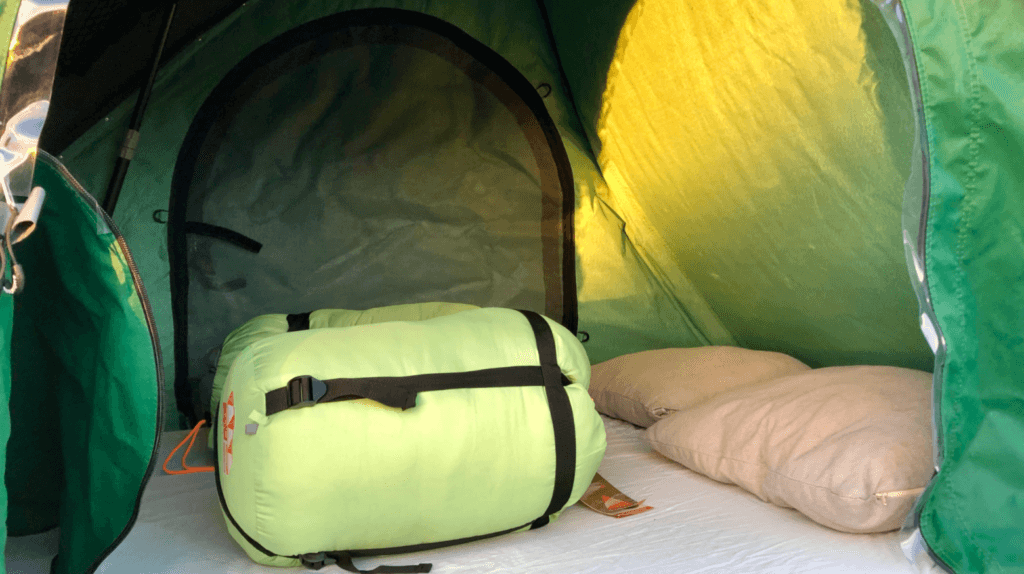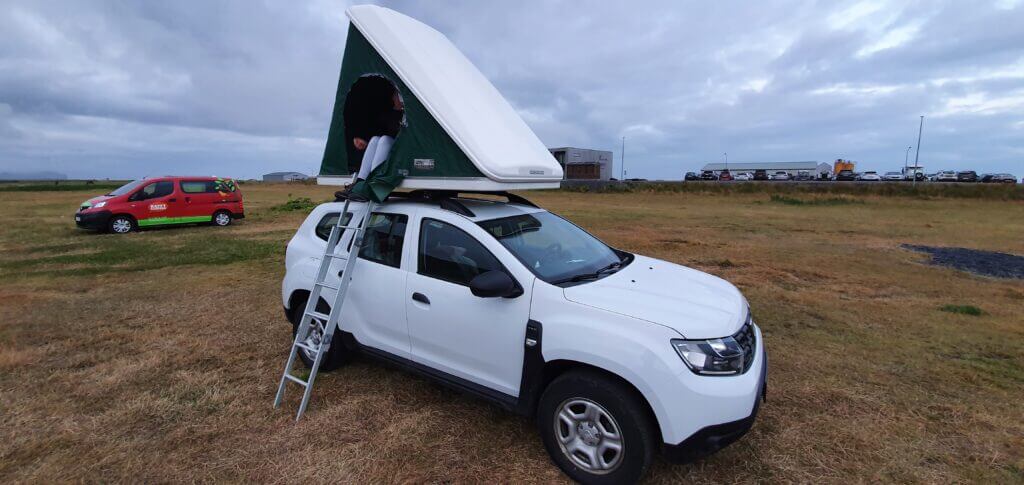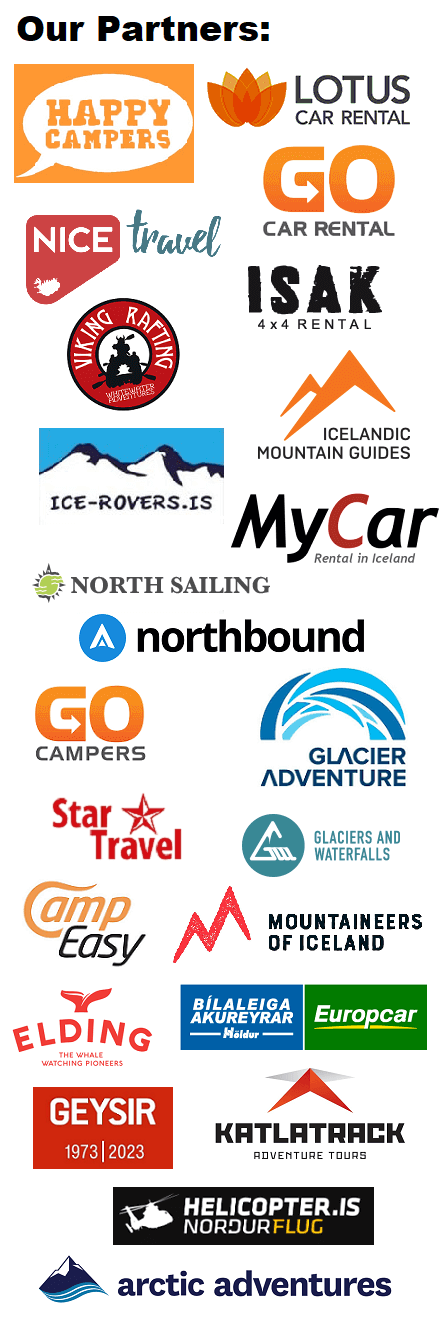Renting a rooftop tent car in Iceland may sound like an unconventional option, but it’s definitely one worth trying! It will give you a huge flexibility, plus a sense of adventure, and for a very affordable price.
A rooftop tent car rental is not without any drawbacks, though. We rented it on our first trip to Iceland and we share all our experiences below.
Contents
Why we rented a Rooftop tent car
We wanted to see a huge number of places and we wanted to be flexible with our plans in case of weather changes. That’s why we ruled out staying at hotels or guesthouses because you have to book those in advance to be sure to have a place. We also ruled out staying in a classical tent, because of the hassle of travelling with it in the aircraft, setting it up every evening, setting it down every morning and being vulnerable to severe weather. And we didn’t own any expensive high-end tent suitable for Iceland.
Hence, we chose a logical option – a car with a rooftop tent. The rooftop tent gave us the flexibility we needed because we could simply arrive at any camping site we wanted. At the same time setting up/down the rooftop tent was really quick and convenient. Not to mention the rooftop tent being a really high-end tent, water and windproof (not for 100% but at least compared to other tents).

Going to sleep in a rooftop tent in Vik campsite
The rooftop tent version of Dacia Duster was about 200Eur more expensive for 11 days than the no-tent version, which was still bearable, given that the minimum price per person for a 1-night stay in a hotel/guesthouse is around 40-50Eur. With a rooftop tent option, you get a mattress with cover and pillows with covers included and you have to bring your own sleeping bags and blankets.
The main pros of a rooftop tent
- flexibility (you can “last minute” decide where to camp)
- easy setup (compared to a classical tent, here it takes literally tens of seconds)
- price compared to hotels (9eur/person/night tent rental + camping price vs min. 40-50eur in a hotel/guest house)
- quality compared to standard tents (the Columbus tent holds better in rain/wind compared to others)
- comfort compared to standard tents (high-quality mattress, good zipping system, and the fact that it sits on the roof of the car because it isolates you from the cold coming from the ground)
The main cons of a rooftop tent
- comfort compared to hotels/guesthouses; yes, this is the biggest one; it’s still a tent so you have to bring good sleeping bags and even then your comfort will be much lower compared to a room – whether we talk about cold weather, need to go out for a toilet/shower or simply the act of changing your clothes 🙂 or eating your breakfast; you have to get used to the camping style, but where else than in Iceland?!
- price compared to standard tents (if you bring your own, you can save those 200eur/11days)

Interior of our Columbus rooftop tent rented via Lotus Car rental
Best Rooftop Tent Car Rentals in Iceland
We highly recommend renting a rooftop tent car with one of the car rental companies below:
- Lotus Car Rental, 5% discount code: epicicelandd5
- Go Campers, 5% discount code: EPICICELAND
- Geysir Car Rental, 5% discount code: EPICICELAND
Why?
- They all have great reviews on Google, Facebook, Northbound, etc.
- They are all locally owned companies with friendly local staff
- They are all reliable and will never scam you for fake damages
A Rooftop Tent Car vs. Other Accommodation Options
The 4 main accommodation options for your Icelandic road trip are:
- Hotels, hostels, guesthouses
- +comfortable
- +choose any car
- -most expensive
- -low to no flexibility
- Camping in the classical tent
- +cheapest
- +flexible
- +choose any car
- -setting the tent up/down
- -not very comfortable
- Camping in the rooftop tent of your car
- +flexible
- +easy setting up/down
- some car types compatible
- middle-value option
- middle-comfort option
- Camping in a campervan
- +flexible
- +easy setup/down
- +quite comfortable
- -more expensive
- -only small/medium 4wd campervans
Our experience with a car with a rooftop tent
My main fear before the trip about our rooftop tent had been whether the mattress and pillows would be comfortable enough. We soon found out the answer – yes, they definitely were. My girlfriend’s main fear had been whether it won’t be too cold for her in the tent and whether the tent is big enough for her (she’s 183cm tall).
Regarding her height – yes, the tent was big enough. However, I would say 2-3cm more in height (i.e. over 185cm) and your comfort will start to decrease with each additional centimetre of yours. It’s definitely possible to sleep even if you are taller though.

Going to sleep in a rooftop tent in Vik campsite
With regards to the fear of feeling cold, her fear turned out to be legitimate (at least for her). Only after I handed her my father’s sleeping bag for -15°C temperatures and she started to wear 4 layers (yes, 4) of clothes as pyjamas, she finally started to feel warm. But that’s women I guess, as I used a -5°C sleeping bag (I would say this is a minimum for Iceland even in summer) and I could comfortably sleep in just 1 layer of thin pyjamas.
If you are like me, and you want to check every detail about the rooftop tent, you may do so here.
And what about tent vs. rain?
Maybe one additional little tent advice. Set up your tent thoroughly in case of rain, it can be really heavy in Iceland. We made a mistake of not thinking hard enough and it cost us a wet interior of the tent and 1-2days of getting it dry again. What exactly happened?
The tent has 2 layers of “isolation fabric” against rain and cold at the bottom on its sides (see picture below). The inner layer is supposed to be tucked between the mattress and the bottom part of the construction of the interior of the tent, or simply said – tucked INSIDE into tent. The outer layer, on the other hand, is supposed to be left OUTSIDE floating in the air a little, so that rain can slip outside by pouring on it. We made a mistake of tucking both 2 layers inside of the tent, which resulted in water slowly pouring to the bottom of our tent, causing the mattress to be partially wet.

Columbus rooftop tent provided by Lotus car rental and its rain isolation layers
The next day we woke up, we had to bring everything out of the tent, including a huge mattress and isolation material below the mattress and get everything to be dry, which can naturally take hours in Icelandic weather conditions. Dumb mistake, so please don’t make it yourself.
It’s also good to set up your tent so that its shell part of the roof is facing the wind. As wind here in Iceland may become quite strong it’s naturally better when it blows into the shell than into the fabric. Overall tent experience has, however, been very cool for me (a bit less for my girlfriend) and I definitely don’t regret choosing this option for our intense summer trip.





Thank you so much for sharing this information, I found all your posts really helpful! I’m planning to rent a 4×4 (Dacia Duster or Jimny), and I was comparing campervan vs rooftop tent. My main concern with rooftop tent is about the wind. Have you ever felt unsafe during your trip?
Hi Clod, thank you, we are glad the posts helped you 🙂
Our rooftop tent was of high quality and we always felt safe. The rooftop tent is heavier and thicker compared to standard tents and it has a shell, which helps a lot against the wind. Yes, the wind may shake the tent slightly and make noises inside the tent, but we found all of these bearable. We never felt like anything dangerous should happen, even during periods of the strong wind. All of this, of course, applies to summer (june-mid sept), I would not got for a rooftop tent outside of this season.
The only issue we had, was my girlfriend feeling slightly cold, but I guess this is more about the sleeping bags and you being used to sleeping in a tent.
Campervans are more comfortable, but they are more expensive and less “agile” on F-roads. We wanted an agile 4×4 car for most of the F-roads, for a reasonable price and we sacrificed a bit of comfort for that – so Duster with rooftop tent was an ideal option for us.
Thank you so much, I really appreciate your tips!
The wind (and cold in general) really concerns me. Did you have any trouble with the wind? I’m trying to choose between a 4×4 pickup+rooftop tent and a 4×4 Dacia Duster campervan. Thank you in advance!
So sorry, I couldn’t see our previous conversation!? Thank you again!!
Hi guys! Thanks for your infos 🙂 i have just one question : in which period have you been in the rood tent?
ThNks a lot 🙂
Hi Annalisa, we were in the rooftop tent from the 1st of August until the 13th of August. Generally it should be fine to use the tent in summer (July, August). With June and September, it may or may not be fine.
https://epiciceland.net/when-to-visit-iceland/
Hi,
Thank you for this useful post. Me and my girlfriend are about to go in next week to Iceland with the same Duster with rooftop tent. My biggest concern is temperature and choosing the right sleeping bag, especially for her. You mentioned you had had -5 and -15. Are those temperatures signs for comfort, limit, or extreme?
Hi Bojan, sorry for a bit late reply!
These were “extreme” temperatures. The comfort temperatures were 0 and -5 if I’m not mistaken. The one with comfort -5 and extreme -15 was just right for my girlfriend 🙂 I was OK with the one 0/-5 too though. It’s important to have “comfort” at 0 or lower I think.
Hello Igor, we plan to visit Iceland in the second half of September. We hope to drive the ring road and some Higlands, we would like to know your opinion about doing this tour in a Duster with a roof tent, at this time of year.
Hi Noelia, it’s doable, just prepare for cold nights (0°C / 32F), and be ready that F-roads may start closing due to winter conditions as soon as early September, though over the past 2 years they remained open until early October.
Hi Igor,
Your website has a lot of information about Iceland, love it!
We are a family of three with a 7-year-old kid. We are planning to go for 7 days, in late July next month. Our rental car is probably a Dacia Duster with a roof tent because we want to explore the light F-road like F35, we just don’t want to encounter extreme river crossings, we want to keep it less risky.
Do you have any F-road recommendations for light SUVs like the Dacia?
You mentioned the cold nights at about 0 degrees, would it be that cold during summer? We are considering adding sleeping bags for each of us.
Hi Eda, thank you very much!
Here is our article on easier F-roads you can pass with Dacia Duster: https://epiciceland.net/top-10-easy-f-roads/, if weather is fine and you cross the rivers properly: https://epiciceland.net/icelandic-rivers-how-to-cross/ then also a beautiful route F208 from the south is possible.
The nights can reach as low as 5°C even in summer around the ring road, and if you sleep in the highlands, e.g. Kerlingarfjoll (https://epiciceland.net/guide-to-kerlingarfjoll/), they can drop as low as 0°C sometimes, not all the time. You can see the current night temperatures here: https://en.vedur.is/weather/forecasts/elements/#type=temp
P.S. If you like what we do please write us a short review on Google: https://g.page/r/CaJt1bHCTbF1EBM/review it would help us a lot!